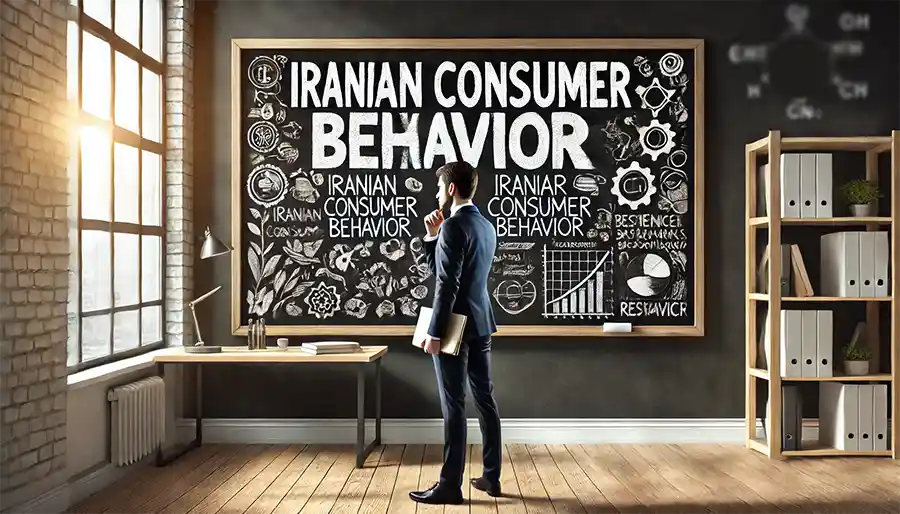Understanding Iranian Consumer Behavior: Trends, Insights, and Opportunities
A Deep Dive into Consumer Preferences, Spending Habits

Introduction: Iran, with its population exceeding 85 million, represents a significant and diverse market for international businesses. Understanding the behavior of Iranian consumers is key for any company looking to enter or expand in this dynamic economy. In this article, we’ll delve into the driving forces behind consumer decisions, exploring everything from economic influences to cultural preferences. This comprehensive overview is designed for investors and business leaders aiming to capitalize on Iran’s untapped market potential.
1. The Demographics of Iranian Consumers
Iran is a youthful nation, with over 60% of the population under 35 years old. This young demographic drives many market trends, especially in digital consumption, fashion, and technology. For example, the smartphone penetration rate stands at an impressive 78%, a critical factor for businesses in e-commerce or digital marketing. Iranian consumers are tech-savvy, spending a significant portion of their disposable income on technology, mobile devices, and related services.
Additionally, Iran’s growing urbanization—where more than 70% of the population resides in cities—has led to a shift in consumer behavior, with a rising demand for modern retail outlets, online shopping, and international brands. In Tehran alone, the spending power and demand for high-quality goods are considerably higher than in rural regions.
2. Economic Factors Influencing Iranian Spending Habits
Iran’s economy has faced multiple challenges over the years, from sanctions to currency devaluation. However, these economic constraints have also created opportunities. For example, the growing demand for affordable, high-quality goods makes Iran a prime market for businesses offering competitive prices.
Statistics indicate that inflation rates in Iran often exceed 40%, pushing consumers to seek better value for their money. This trend has heightened the focus on price-sensitive purchasing, with over 65% of urban consumers citing price as the primary factor when choosing products. However, despite economic pressures, spending on necessities such as housing, food, and transportation remains steady, accounting for over 70% of household expenditures.
3. Cultural and Social Drivers of Consumer Preferences
Iranian culture places significant emphasis on family and social gatherings, influencing the types of goods and services that thrive. For example, food and beverage industries are consistently robust, with Iranians spending over 30% of their disposable income on dining, groceries, and hospitality. Brands that cater to the importance of hospitality in Iranian culture, such as premium tea and coffee or modern dining solutions, have significant growth potential.
The cultural attachment to luxury is another important factor to consider. While the general perception might be that sanctions reduce access to luxury goods, Iran still boasts a thriving luxury market. According to a 2023 report, luxury vehicle imports, despite restrictions, saw a 5% growth in market share. This showcases a robust desire for high-end goods, particularly among affluent consumers in cities like Tehran and Mashhad.
4. E-Commerce and Digital Consumer Behavior
The shift towards online shopping in Iran has been rapid, accelerated by a combination of youthful demographics and widespread internet access. In 2022, the e-commerce sector in Iran grew by over 34%, making it one of the fastest-growing markets in the region. More than 70% of the population uses smartphones, and mobile commerce now accounts for over 40% of all online purchases.
Social media also plays a crucial role in influencing buying decisions, with platforms such as Instagram and Telegram being key marketing channels. In fact, a 2021 survey found that 48% of Iranian consumers discover new products through social media, making it an essential tool for international brands looking to establish a foothold in the market.

Key Players in Iran’s E-commerce Market
The Iranian e-commerce landscape is dominated by a few major platforms, each catering to different sectors and consumer needs. These platforms are not only influential but also reflect the diverse interests of Iranian consumers.
- Digikala (دیجیکالا):
As the largest and most recognized e-commerce platform in Iran, Digikala holds over 85% of the online retail market share. It offers a wide range of products, including electronics, fashion, home goods, and groceries. Digikala’s business model is similar to Amazon, providing both a marketplace for third-party sellers and direct sales from its own inventory. The platform sees millions of daily visits, making it a critical player for any brand looking to penetrate the Iranian market. - Bamilo (بامیلو):
Although Bamilo is no longer operational, it was once a prominent competitor to Digikala. Its closure in 2019 reflects the challenges of competing in Iran’s tough market environment, but it also illustrates the dominance that Digikala has been able to maintain. - Snapp (اسنپ):
Snapp started as a ride-hailing service but has expanded its services to include food delivery (SnappFood), grocery delivery (SnappMarket), and even courier services (SnappBox). With its robust user base and expansion into multiple sectors, Snapp is a key player in Iran’s e-commerce and digital services ecosystem. Its influence is particularly significant in urban areas where on-demand services are in high demand. - Torob (ترب):
Torob is a price-comparison website that has gained popularity due to its ability to help consumers find the best deals across multiple Iranian online retailers. This platform aggregates products from various e-commerce sites, offering users a comprehensive overview of available products and prices, which in turn drives consumer spending behavior. - Divar (دیوار):
Divar operates as a classifieds platform, where users can buy and sell second-hand goods. It has become one of the most popular websites in Iran, particularly for selling used electronics, cars, and home appliances. Its peer-to-peer marketplace model has created a large community of users who are comfortable with online transactions. - Sheypoor (شیپور):
Similar to Divar, Sheypoor is a classifieds site focused on second-hand goods. While it doesn’t have the same scale as Divar, it remains a relevant player in the online marketplace, particularly in smaller cities and rural areas.
5. Opportunities for Foreign Businesses
Despite sanctions and economic instability, there are significant opportunities for foreign investors in Iran. The pharmaceutical, technology, and renewable energy sectors offer particularly high growth potential. For example, Iran’s renewable energy market is expected to grow by 12% annually, driven by government initiatives and a population increasingly concerned with sustainability.
In addition, as Iran seeks to diversify its economy beyond oil, the demand for foreign expertise in infrastructure, financial services, and consumer goods is growing. Businesses that can navigate the regulatory landscape and offer products or services tailored to local preferences will find a receptive market. For instance, brands that emphasize sustainability, affordability, and digital convenience will have a distinct advantage.
6. Key Statistics: A Snapshot of Iranian Consumer Behavior
- Smartphone penetration: 78% of the population
- Urbanization: Over 70% of the population lives in urban areas
- E-commerce growth: 34% annual growth in 2022
- Inflation rate: Averaging over 40% in recent years
- Luxury market: 5% growth in luxury vehicle imports in 2023
- Social media influence: 48% of consumers discover new products through social platforms
Conclusion
The Iranian consumer landscape is evolving rapidly, presenting numerous opportunities for businesses ready to adapt to its unique economic and cultural dynamics. Understanding Iranian consumer behavior—characterized by price sensitivity, cultural influences, and an increasing shift towards digital platforms—is critical for success. By focusing on affordability, leveraging digital marketing, and offering products that align with local preferences, international companies can effectively tap into one of the Middle East’s largest and most dynamic markets.
Sources and References
- Statistical Center of Iran – Population demographics and urbanization rates in Iran. Available at: amar.org.ir
- World Bank Data – Economic indicators, including inflation rates and GDP trends in Iran. Available at: www.worldbank.org
- Statista – Insights on smartphone penetration and e-commerce growth in Iran. Available at: www.statista.com
- International Trade Centre (ITC) – Reports on Iran’s import and export markets, focusing on luxury goods and consumer behavior. Available at: www.intracen.org
- Euromonitor International – Analysis of consumer spending habits and market potential in the Middle East, including Iran. Available at: www.euromonitor.com
- Iran Chamber of Commerce – Reports and articles on economic conditions and business opportunities in Iran. Available at: www.tccim.ir
- Middle East Institute (MEI) – Research papers on Iran’s economic diversification efforts and renewable energy growth. Available at: www.mei.edu







